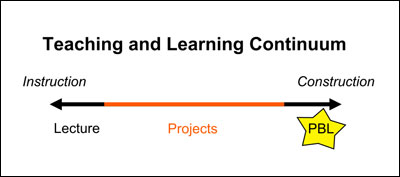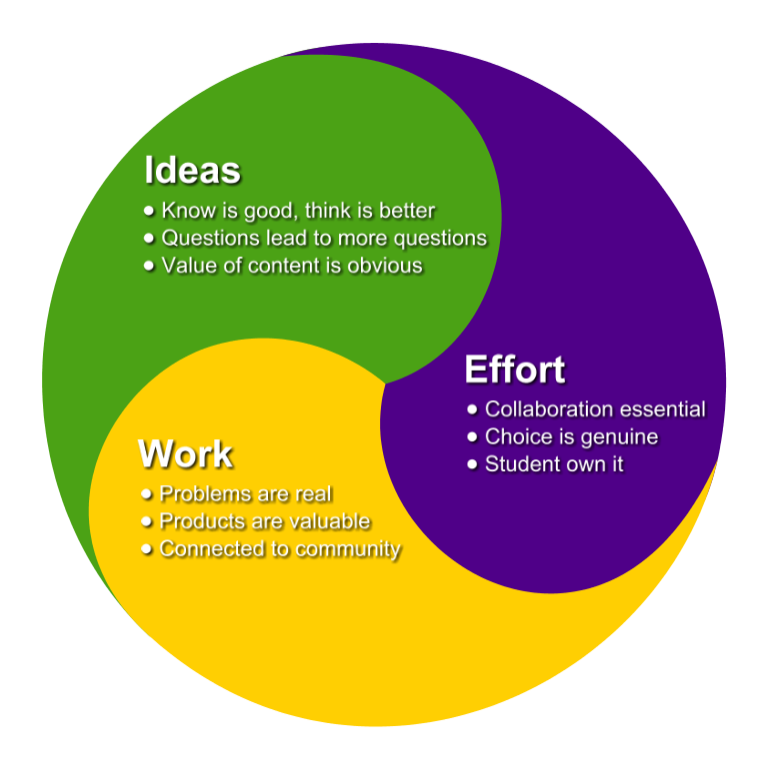Make It Matter!
Move from projects to Project-based Learning by focusing on ideas, work, and effort

At a time when there is a lot of shallow, on-demand information, we need to encourage deep thinking and creative problem solving. Project-based learning provides an effective model to engage students in deep thinking, while connecting their learning to the real world.
Is this project project-based?
In a project-based approach to teaching and learning, students work to apply what they know to solve a real-world problem. Students explore the curriculum in depth as they apply knowledge to resolve questions, determine connections, and assess relationships. During the project-based learning process, students also engage and hone thinking, communication, leadership, collaboration, and other essential 21st century skills.
Lillian Katz shares that project work “provides children with the opportunity to apply skills; (2) addresses children's proficiencies; (3) stresses intrinsic motivation; and (4) encourages children to determine what to work on and accepts them as experts about their needs.” (Katz, 1994).
There is widespread use the terms “project” and “project-based learning.” While there are benefits to both, they are not the same thing.
Why PBL and not just projects?
While we may not yet be agreement about what exactly education today should look like, talking at students and stuffing their heads with facts is not longer enough. We may want every student to go to college and get a degree, but the reality is that many of them do not.
Project-based learning helps us engage learners today, keeping them in school and providing opportunities to learn skills that will help them meet the challenges of the world to come, regardless of whether they go to college or not.
On the continuum of teaching and learning, where instruction is on one end and construction the other, project-based learning falls at the constructivist end. Projects can be applied in a wider range of areas, depending on their requirements and organization.

We can push the learning in our classrooms from projects to project-based learning by focusing on ideas, work, and effort that matters.
Ideas that Matter
For the most part, the “what” we teach in classrooms seems pretty straightforward. We have textbooks, standards, and elaborate scope and sequences that tell us what to cover ... but the goal of project-based learning isn't to cover. It’s to uncover.
A project-based approach focuses on depth over breadth. It is as much about thinking as it is about knowing. It recognizes the importance of internalizing and contextualizing information in meaningful ways.
If we want students to uncover, we have to give them time. Time to explore, time to wonder, time to question ... and that’s before the uncovering even begins! Time is likely to be a resource you do not have in abundant supply, so the ideas explored through a project-based approach need to address the most important questions in your discipline.
We have all heard a student say, “Why do I have to learn this?” Since project-based learning requires students to know and use knowledge to develop their ideas or determine potential solutions, it helps students see clearly why the content is important.
If we want to move toward project-based learning, we must identify what learning is truly essential in our class or course. What is worth exploring deeply? What isn’t? Be prepared to back up your choices, as you will (and should) be asked by administrators, parents, students, and teachers.
Great questions for project-based learning do not lead to answers - they beget even more questions and inquiry. Truly important questions also require students to utilize knowledge of many subjects. What questions can you ask your students that will help drive them toward deep thinking?
Share your big ideas and essential questions with other teachers to see where you can find intersections and commonalities. Working together yields additional ideas and perspectives and often helps you clarify your thinking. Collaboration makes it easier to form instructional teams for project-based learning.
Work that Matters
In the project-based classroom, the traditional roles of teacher and student are blurred. Students, whether exploring on their own or in a group, are likely to investigate and study beyond the knowledge of their teacher.
This need to know is driven by work that matters. In a project-based approach, student work centers around real problems and issues; things people face beyond an academic setting. If the problems are real, students need to become content experts in order to solve them.
A project-based approach asks students to apply knowledge in situations where there is a lot at stake. A meaningful PBL project requires students to solve important problems and create products that are important to someone beyond the walls of the classroom. Teaching or developing academic content for other students at other ages in not project-based learning. Student work needs to matter beyond the academic community.
We often think about expanding the audience for student work, and technology certainly makes it easy to post student products for a global audience. PBL requires that we consider not just the audience's distance from the classroom, but to consider how they feel about the value of student work.

Presenting to parents is almost always rewarding, but many of them will show up in support regardless of the level of students' deliverables. Parents can be a highly focused audience if students’ work is beneficial or valuable to them. For example, as part of a nutrition and physical activity project, students might work to find solutions to healthier eating and exercise that work for their own families. You could even hold a health fair where interested families could learn lots of new ideas.
In a project-based approach that is student-driven, the audience for each student or group may not be the same. Some students could work to improve the nutrition of the school lunch program, collaborating with the cafeteria manager and food service organization to find healthier options students will actually eat and meet budgetary realities. Other students might work to find ways for students and teachers at their site to be more active during the school day.
In a project-based approach, we need to consider the specific person, organization, or group that benefits from the work students are doing. Student work is most authentic when it arises naturally to address an obvious need or a cause they have identified and are inspired to join.
In the same way we ask ‘who cares?” about the ideas we are exploring, we can ask “who does this?” to get a better sense of the connection beyond the classroom. This is also the perfect opportunity to connect with experts who can share important content and process as students begin work as well as form part of the evaluation team at the culmination of the project.
Effort that Matters
Project-based learning is hard. Sure, it’s hard for teachers, but it's hard for students too. By “hard,” I don’t mean it’s just intellectually difficult ... it truly is hard work!
Expending a great deal of time and effort demands that the process is meaningful. We can make this hard work a lot more enjoyable for our students if we make sure it includes learner choice, learner control, and learning together.
Choice is crucial to getting students engaged, involved, and responsible for project work. The earlier we can involve them in the process, the better.
Giving a list of options to students for project topics isn’t really choice. Ideas and content that matters are still going to drive the focus of what we choose for project-based learning. That doesn’t make it easy to involve students. Taking the time to listen to their comments and discussions can help us determine ways to make choice less artificial.
The PBL process is perfect place for giving choice. If the problem or task is suitably real, you alone can’t envision exactly what it should look like. What a solution or product should look like and how to share it with the world should be wide open for students.
Love making movies? Then share your solution through an advertisement, or public service announcement, or movie short. Love to draw? Create a diagram. When students choose how they will showcase their work, they naturally differentiate based on interest, ability, and experience. It becomes your job to coach them.
As long as the medium conveys the message, it doesn’t matter what medium they choose. Latitude in medium provides additional opportunities to build communication, creativity, and critical thinking skills as they decide. Because so much of project-based learning is organic, leading us where questions and needs demand, it is almost impossible to plan out exactly what is going to happen each day. This forces teachers to become facilitators and naturally moves both control and responsibility to students.
Because PBL asks students to solve real problems and challenges them with real tasks, it is difficult to implement true project-based learning without incorporating collaboration. Giving students opportunities to work together is another way to make learning fun and to build skills that are essential both in higher education and in the workplace.
While choosing your friends as your collaborators may not yield the best results, we need to give students opportunities to work together to build collaboration skills. The process of working together helps students reflect on their own strengths and weaknesses and learn how to utilize the strengths of others to reach shared goals. Working with others opens us up. We see firsthand how individuals can view things differently, and we learn to take risks, try new things, and grow together.
Finally, students need to realize that the project is theirs. Where they took the ideas, what they chose to work on, and the effort they put into the process should be a reflection of the individuals who worked together on the project. All the thinking, hard work, and effort are worthwhile when it is easy to see and when every learner can say, “This is mine!”
Putting It Together
Consider a typical elementary state report. Once just a handwritten or typed report, state projects today may be fancy videos or involve students presenting to the entire school ... but the content hasn’t evolved the way the delivery medium has. These reports are often a collection of facts and little more - the capital, the state bird, the state flower, and facts and figures about agriculture and population. When a student’s work is about something, it is just a project.
Students’ artifacts and performances in project-based learning may contain information and facts about a topic, but a mere fact dump is never the goal of PBL.
A local travel agency would like to see more people travel for spring break. Apply what you know about the state of [Insert name here] to create a spring break itinerary for a family of four that includes at least one unique geographic feature, one historical highlight, and one current point of interest.
This has more promise as a project-based approach. It involves higher-level thinking and applying knowledge (ideas that matter). It crosses the boundary between social studies and language arts, and could even include math if you include a budget requirement. It also seems to have real-world connections to tourism and family.
But is the work students are doing work that matters? To move beyond just a project, there should be a real travel agency that needs this help, or tourism board that needs help with marketing. Yes, students can present to their families, but the audience is still artificial, the task is fictitious, and the value of the work is low if the audience that sees these projects isn’t really going to use the information to make an informed decision about an upcoming trip.
The process isn’t overly specified so it also the potential for effort that matters. With an obvious focus on learning about locations in the United States, choice remains somewhat limited as far as content. But with open parameters requiring students to research and choose which geographic and historical content to include, there are no &lrdquo;canned” answers.

While everyone may create an itinerary that addresses the predefined set of expectations, each learner or group has latitude to showcase their work as a presentation, a video advertisement, a print brochure, and more.
The goal of this article isn’t merely to provide a checklist to gauge whether an activity is a project or is project-based learning. Rather, the goal is to remind you to focus on ideas that matter, work that matters, and effort that matters to help you keep classroom learning headed in the right direction.
References
Katz, L.G. and Chard, S.C. (2000) Engaging Children's Minds: The Project Approach, 3rd Edition. Stamford, CT: Ablex.














